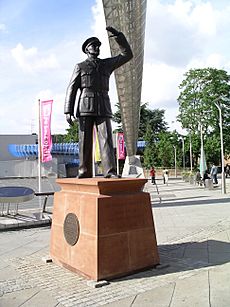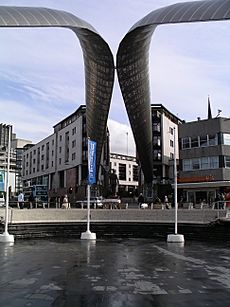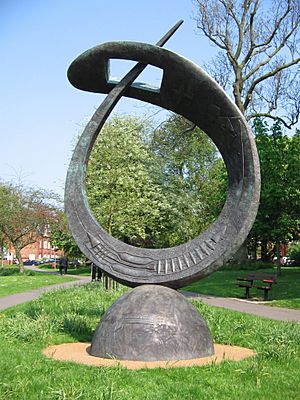Frank Whittle facts for kids
Quick facts for kids
Sir Frank Whittle
|
|
|---|---|
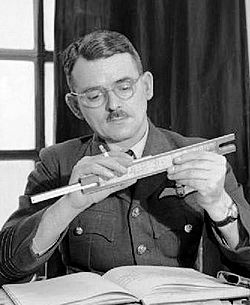 |
|
| Born | 1 June 1907 Earlsdon, Coventry, England |
| Died | 9 August 1996 (aged 89) Columbia, Maryland, United States |
| Buried |
Cranwell, England
|
| Allegiance | United Kingdom |
| Service/ |
Royal Air Force |
| Years of service | 1923–1948 |
| Rank | Air Commodore |
| Battles/wars | Second World War |
| Awards | Member of the Order of Merit Knight Commander of the Order of the British Empire Companion of the Order of the Bath Commander of the Legion of Merit (United States) Rumford Medal Louis E. Levy Medal Fellow of the Royal Society Honorary Fellow of the Royal Aeronautical Society Charles Stark Draper Prize Prince Philip Medal |
| Spouse(s) |
Dorothy Lee
(m. 1930; div. 1976)Hazel Hall
(m. 1976) |
| Other work | BOAC technical advisor, Shell engineer, engineer for Bristol Aero Engines, NAVAIR Professor at the US Naval Academy |
Air Commodore Sir Frank Whittle (born June 1, 1907 – died August 9, 1996) was a brilliant English inventor and Royal Air Force officer. He is famous for helping to invent the turbojet engine, which powers most modern airplanes. While others had similar ideas, Whittle's designs were developed earlier than those in Germany.
From a young age, Whittle loved engineering and dreamed of flying. He faced challenges joining the RAF because of his height. But he was determined and eventually got in. He became an aircraft apprentice, learning all about engines. His skills earned him a spot at officer training at Cranwell. There, he became a great pilot and, while studying, came up with the basic ideas for the jet engine. He even got a patent for his design in 1930. He continued his studies at Cambridge University, where he did very well.
Without much help from the government, Whittle and two friends started a company called Power Jets Ltd. They worked with another firm to build his engine. Even with little money, they created a working model that first ran in 1937. This success finally got the government interested, and they started funding more engine development. However, the pressure of this work made Whittle very ill. He retired from the RAF in 1948 and was given a special honor called a knighthood. He later worked as an advisor for airlines and engineering companies. In 1976, he moved to the United States and taught at the United States Naval Academy. Sir Frank Whittle passed away in 1996. He is remembered as one of the most important inventors in aviation history.
Contents
Early Life and Big Dreams
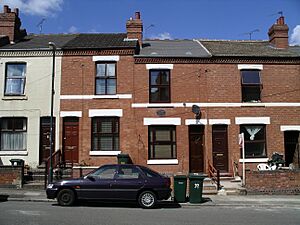
Frank Whittle was born in Coventry, England, on June 1, 1907. He was the oldest son of Moses Whittle, who was a very clever engineer. When Frank was nine, his family moved to Royal Leamington Spa. His father bought a small company that made engine parts. Frank learned a lot about engineering by helping in his father's workshop.
Frank was a curious and adventurous boy. He loved to read, spending hours in the library learning about space, engines, and how planes fly. By age 15, he was set on becoming a pilot. He applied to join the RAF.
Joining the Royal Air Force
In January 1923, Frank passed the RAF entrance exam with high marks. But he was turned down because he was too short and his chest was too small. He didn't give up! He followed a tough exercise and diet plan to get stronger. Six months later, he tried again but was still rejected.
Still determined, he applied a third time using a different name. This time, he passed the physical test. In September 1923, Frank Whittle began his three-year training as an aircraft mechanic at RAF Cranwell. He found the strict rules hard, and at one point, he thought about leaving.
However, Frank loved building model aircraft. His models were so good that his commanding officer noticed. The officer also saw that Frank was very good at math. In 1926, he recommended Frank for officer training at RAF College Cranwell. This was a huge chance for Frank, as it meant he could become an officer and learn to fly!
At Cranwell, Frank did very well in his studies. He flew solo (by himself) after only 13.5 hours of training. He quickly became known for his daring low-flying and aerobatics. For graduation, each student had to write a report. Frank chose to write about future aircraft designs, especially flying very high and fast (over 500 mph). He explained that regular propeller engines wouldn't be enough. Instead, he described an engine that used a piston engine to push air into a burning chamber, creating thrust. This was an early idea for a jet engine.
Frank graduated in 1928 at age 21. He was second in his class for academics and won an award for his report. He was a talented pilot, but his logbook showed warnings about being too daring.
Developing the Jet Engine
After graduating, Frank Whittle continued to think about his jet engine idea. He knew it could change aviation. In 1930, he received a patent for his design. However, the Air Ministry (the government department in charge of air travel) wasn't interested in his idea. They thought it was too risky and expensive.
Despite the lack of official support, Whittle didn't give up. In 1936, he teamed up with two retired RAF officers and formed a company called Power Jets Ltd. They worked with a company called British Thomson-Houston to build a prototype engine. They had very little money, but their hard work paid off.
On April 12, 1937, their first engine, the WU, successfully ran on a test stand. This was a huge moment! It proved that Whittle's idea could work. After this success, the Air Ministry finally became interested. They started giving contracts to Power Jets to develop more powerful engines.
However, the constant pressure and stress of developing the engine took a toll on Whittle's health. He suffered a nervous breakdown in 1940. In 1944, Power Jets was taken over by the government. Whittle again suffered from stress and left the company in 1946.
Life After the War
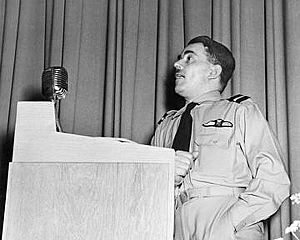
In 1946, Whittle became a technical advisor for engine design. He received several honors for his work. In May 1948, he was given £100,000 by the Royal Commission on Awards to Inventors for his jet engine work. Two months later, he was made a Knight Commander of the Order of the British Empire, which meant he was now "Sir Frank Whittle."
In August 1948, Sir Frank Whittle retired from the RAF due to health reasons, with the rank of air commodore. He then joined BOAC as a technical advisor for jet engines. He traveled a lot, seeing how jet engines were being developed around the world.
In 1952, he left BOAC and wrote a book about his life and the jet engine, called Jet: The Story of a Pioneer. He also worked for Shell, where he developed a new type of drill powered by a turbine. This drill was used for oil and gas exploration. He later worked for Bristol Aero Engines, continuing his work on turbine technology.
Later Life and Legacy
In 1976, Sir Frank Whittle moved to the United States. He married Hazel S. Hall and accepted a position as a research professor at the United States Naval Academy in Annapolis, Maryland. He focused his research on how air flows around objects. He also wrote a textbook about gas turbine engines.
In 1978, Whittle met Hans von Ohain, a German engineer who also developed a jet engine around the same time. At first, Whittle thought von Ohain had copied his ideas. But after talking, he realized von Ohain's work was independent. They became good friends and often gave talks together.
Sir Frank Whittle passed away from lung cancer on August 9, 1996, in Columbia, Maryland. His ashes were brought back to England and placed in a church in Cranwell.
Whittle's invention changed air travel forever. Jet engines made planes much faster and more efficient, allowing for modern air travel as we know it. He received many awards and honors throughout his life for his incredible contributions to engineering and aviation.
Memorials and Tributes
Sir Frank Whittle is honored in many places, especially in England where he was born and did much of his work.
In Coventry, England
- The "Whittle Arch" is a large, wing-shaped structure outside the Coventry Transport Museum.
- A statue of Sir Frank Whittle stands under the Whittle Arch. It shows him looking up at the sky, imagining the first jet flight.
- A school in Coventry, Sir Frank Whittle Primary School, is named after him. It even has a replica jet engine in its reception area.
- A plaque marks the house in Earlsdon, Coventry, where he was born.
- On Hearsall Common, a plaque remembers where Whittle first felt inspired by flight.
- Coventry University has a building named after him.
- The main hangar at the Midland Air Museum is called The Sir Frank Whittle Jet Heritage Centre.
In Lutterworth, England
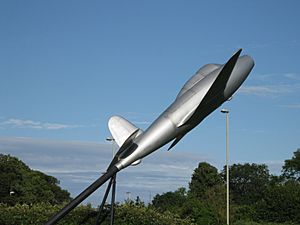
- The Sir Frank Whittle Studio School is a school named in his honor.
- Lutterworth Museum has a large collection of Whittle's original papers and artifacts.
- A memorial with a bust of Frank Whittle stands in a roundabout outside Lutterworth, where much of his jet engine development took place.
In Rugby, England
- In Rugby, where Whittle built his first engines, there is a bronze sculpture called Frank Whittle - Father of the Jet Engine. It shows a propeller changing into a jet engine turbine.
Other Memorials
- Peterhouse, his college at Cambridge University, has a Whittle Building.
- The Department of Engineering, University of Cambridge has a Whittle Laboratory.
- A full-size model of the Gloster E28/39 (the first British jet aircraft) is outside Farnborough Airfield.
- The Sir Frank Whittle Medal is given each year by the Royal Academy of Engineering to a British engineer for outstanding achievements.
- Roads in Derby and Burnham are named after him.
- Whittle Hall is a main building at the Royal Air Force College Cranwell.
- The main office complex at the Rolls-Royce Bristol site is called Whittle House.
- A memorial stone is placed in the Royal Air Force Chapel in Westminster Abbey.
- His honors, medals, and awards are displayed at the Royal Academy of Engineering in London.
Images for kids
See also
 In Spanish: Frank Whittle para niños
In Spanish: Frank Whittle para niños


